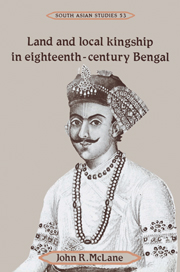Book contents
- Frontmatter
- Contents
- List of tables
- Preface and acknowledgments
- List of abbreviations
- Select glossary
- Map of southwest Bengal
- Part I Bengal
- Part II Burdwan
- 6 Mughal Burdwan and the rise of the Burdwan raj
- 7 Burdwan's expansion
- 8 The Maratha invasions, 1742-1751
- 9 Zamindars and the transition to Company rule
- 10 The famine of 1770
- 11 Revenue farming, 1771-1777
- 12 Zamindari family politics: the Burdwan raj, 1770-1775
- 13 The politics of Burdwan family debt and marriages, 1775-1778
- 14 Testing the limits, 1778–1790
- 15 Burdwan under the Decennial and Permanent Settlements
- 16 Patnis and the elusive quest for independence and security
- 17 Conclusion
- Bibliography
- Index
- Cambridge South Asian Studies
6 - Mughal Burdwan and the rise of the Burdwan raj
from Part II - Burdwan
Published online by Cambridge University Press: 13 October 2009
- Frontmatter
- Contents
- List of tables
- Preface and acknowledgments
- List of abbreviations
- Select glossary
- Map of southwest Bengal
- Part I Bengal
- Part II Burdwan
- 6 Mughal Burdwan and the rise of the Burdwan raj
- 7 Burdwan's expansion
- 8 The Maratha invasions, 1742-1751
- 9 Zamindars and the transition to Company rule
- 10 The famine of 1770
- 11 Revenue farming, 1771-1777
- 12 Zamindari family politics: the Burdwan raj, 1770-1775
- 13 The politics of Burdwan family debt and marriages, 1775-1778
- 14 Testing the limits, 1778–1790
- 15 Burdwan under the Decennial and Permanent Settlements
- 16 Patnis and the elusive quest for independence and security
- 17 Conclusion
- Bibliography
- Index
- Cambridge South Asian Studies
Summary
The Burdwan raj and other expanded local kingdoms of eighteenth-century Bengal were products of nawabi patronage rather than military adventurism. Whether the productive partnership between the Punjabi ancestors of the Burdwan raj family and the Mughals began outside of Bengal or within is not known. The collaboration was established by 1657 when the Mughal government appointed Abu Rai to the office of kotwal (police officer) in Burdwan town. By 1680, the Burdwan family had obtained a small zamindari and had entered the Mughal revenue-collecting hierarchy. In subsequent decades, the Burdwan zamindari expanded over hundreds of villages and gained broad autonomy over its internal affairs. By the mid-eighteenth century it covered some 5,000 square miles and was a virtual Hindu kingdom within the weakening provincial Mughal hegemony.
The Burdwan raj family was geographically positioned to benefit from Mughal favor by virtue of its domicile, first near and then in Burdwan town. From the outset of Mughal rule in Bengal, Burdwan was a vital imperial outpost from which Mughal armies had marched to fight the Afghans who had previously ruled Bengal and to bring the largely independent chiefs to the south and west of Burdwan under Mughal administration. The town of Burdwan lies on the northern bank of the Damodar river, some 75 miles by the Grand Trunk Road northwest of Calcutta. The Damodar was more a hindrance to than a facilatator of Mughal Bengal's integration. The river's broad, sandy bed was fordable in the dry season but the river was unbridged and the river was navigable by small boats in its central and upper reaches only for a brief spell each year.
- Type
- Chapter
- Information
- Land and Local Kingship in Eighteenth-Century Bengal , pp. 125 - 138Publisher: Cambridge University PressPrint publication year: 1993



